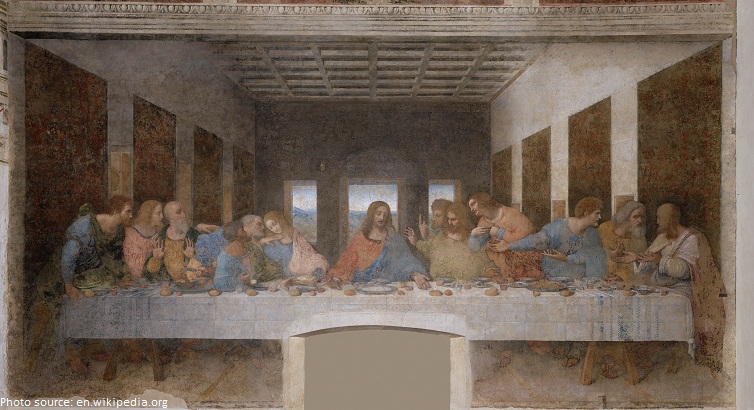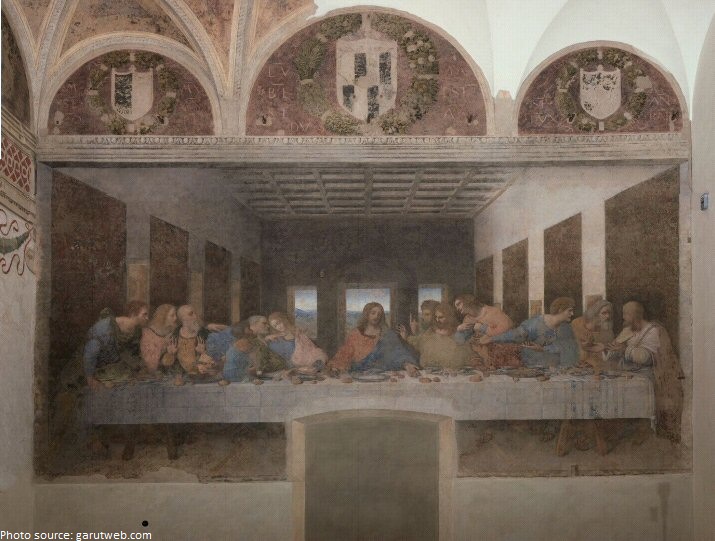The Last Supper is a late 15th-century mural painting by Leonardo da Vinci in the refectory of the Convent of Santa Maria delle Grazie, Milan.
Leonardo da Vinci began working on it in 1495, and finished “The Last Supper” in 1498.
It is one of the world’s most famous paintings, and one of the most studied, scrutinized, and satirized.
There are many reproductions have been made in all sizes, but the original is 4.6 meters x 8.8 meters (15 feet × 28.8 feet).
The subject of the Last Supper is Christ’s final meal with his apostles before Judas identifies Christ to the authorities who arrest him.
The Last Supper is remembered for two events:
Christ says to his apostles “One of you will betray me,” and the apostles react, each according to his own personality. Referring to the Gospels, Leonardo depicts Philip asking “Lord, is it I?” Christ replies, “He that dippeth his hand with me in the dish, the same shall betray me” (Matthew 26). We see Christ and Judas simultaneously reaching toward a plate that lies between them, even as Judas defensively backs away.
Leonardo also simultaneously depicts Christ blessing the bread and saying to the apostles “Take, eat; this is my body” and blessing the wine and saying “Drink from it all of you; for this is my blood of the covenant, which is poured out for the forgiveness of sins” (Matthew 26). These words are the founding moment of the sacrament of the Eucharist (the miraculous transformation of the bread and wine into the body and blood of Christ).
The effect of his statements causes a visible response, in the form of a wave of emotion among the apostles. These reactions are quite specific to each apostle, expressing what Leonardo called the “motions of the mind.”Despite the dramatic reaction of the apostles, Leonardo imposes a sense of order on the scene.
The painting contains several references to the number 3, which represents the Christian belief in the Holy Trinity. The Apostles are seated in groupings of three; there are three windows behind Jesus; and the shape of Jesus’ figure resembles a triangle. There may have been other references that have since been lost as the painting deteriorated.
Leonardo, always the inventor, tried using new materials for “The Last Supper.” Instead of using tempera on wet plaster (the preferred method of fresco painting, and one which had worked successfully for centuries), he thought he’d give using dry plaster a whirl. His experiment resulted in a more varied palette, which was his intent.
Because the painting was on a thin exterior wall, the effects of humidity were felt more keenly, and the paint failed to properly adhere to the wall. Because of the method used, soon after the painting was completed on February 9, 1498 it began to deteriorate.
By the second half of the sixteenth century Leonardo’s biographer Giovan Paulo Lomazzo stated that, “…the painting is all ruined.” Over the past five hundred years the painting’s condition has been seriously compromised by its location, the materials and techniques used, humidity, dust, and poor restoration efforts.
Modern problems have included a bomb that hit the monastery destroying a large section of the refectory on August 16, 1943, severe air pollution in postwar Milan, and finally, the effects of crowding tourists.
There have been seven documented attempts to repair the Last Supper. The first restoration effort took place in 1726, the last and most extensive was completed in 1999.
Number of years after its completion that deterioration was noted: 18
Number of bombs that have hit the refectory: 1
Number of years needed to complete the recent conservation project: 22
Number of years that Leonardo needed to complete the painting: 4
Number of research studies produced during conservation project: 60
Number of hours spent on the conservation project: 50,000
The surface that is lost: 17.5%
The surface painted during the seven previous restorations: 40%
The surface that was painted by Leonardo: 42.5%
The Last Supper has also been the target of much speculation by writers and historical revisionists alike,usually centered on purported hidden messages or hints found within the painting.
Facts inclde Essay by Dr. Beth Harris and Dr. Steven Zucker

